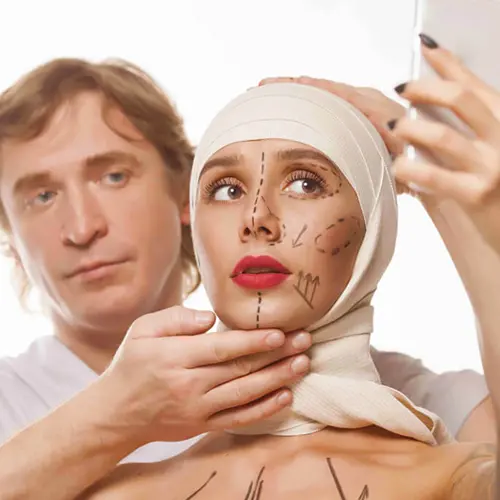Table of Contents
Rhinoplasty is an operation that helps to reshape the nose and improve its functions when needed. Generally, it’s thought to change the nose size and make it more symmetrical. But, how do you know which one is suitable for you?
Actually, your surgeon will decide on the correct procedure or procedures after seeing your nose. Therefore, different types of rhinoplasty procedures are determined by your surgeon according to your nose’s needs.
In this article, we will take a look at these different rhinoplasty procedures and their gains, along with the needed situations and other additional supported operations to achieve an aesthetic appearance, healthy nose, etc.
Open Rhinoplasty: Advantages and Techniques
Open rhinoplasty is a technique used to shape and improve the nose. The surgeon creates a small incision under the nose along with the nostrils, generally, it looks like the letter Z - it may differ from surgeon to surgeon. By making a small incision, the surgeon can access the inside of the nose more easily.
The advantages of this technique are can be listed like these:
- Accessibility: Even the small incision gives access to your surgeon to make changes more efficiently. They can see the inside clearly and this method is often used in operations that are focused on aesthetic appearance.
- Control: Your surgeon can have both access to and control of the nose. By having both of them, the results would be more predictable.
Closed Rhinoplasty: A Minimally Invasive Approach
Closed rhinoplasty is a procedure that approaches the nose minimally through the nostrils with the help of medical instruments. This procedure allows surgeons to make changes to the nostrils, bridge, tip of the nose, etc.
Since the surgery happened inside the nose, there would be no stitches or scarring on the surface. The incisions are closed by dissolvable stitches. This method can be used for both aesthetic and functional changes, and recovery time is shorter when compared to open rhinoplasty - a traditional approach.
However, please note that not all patients are suitable for closed rhinoplasty. Your surgeon would decide which procedure is the best for you after an examination.
Revision Rhinoplasty: Correcting Previous Surgeries
As the name suggests, revision rhinoplasty is a procedure that is applied to make corrections after the first operation. Generally, rhinoplasty is a reliable and safe surgery but sometimes, complications can happen. It is not unusual for surgeries. Or, you may not achieve the desired results.
Revision rhinoplasty is considered more complex and challenging when compared to the first one because the changes were already made months or years ago and it takes a long time to recover.
Therefore, choosing your surgeon before this operation is essential to make changes more efficient than before.
The procedure includes correction of the nasal bridge and removal of the needed parts such as cartilage. The incisions are often made internally, though external ones can be made in some cases.
Non-Surgical Rhinoplasty: A Less Invasive Alternative
Non-surgical rhinoplasty, or liquid rhinoplasty, is a technique that alternative to traditional operations. It’s mostly preferred for minor aesthetical reasons. It takes 15-30 minutes to complete.
The fillers are injected into the needed area, and mostly it's the bridge of the nose to correct the asymmetrical appearance. The quality of the injection is an important thing here.
Even though it's less painless and easy to recover when compared to the other procedures, the results of non-surgical rhinoplasty are temporary - for 6-12 months in total.
Ethnic Rhinoplasty: Tailoring the Procedure to Unique Features
Being different from other techniques, ethnic rhinoplasty aims for preserving the patient’s ethnic identity and promote its features. Therefore, the areas that the surgeons focus on differ from patient to patient. We can say that ethnic rhinoplasty is a personalized operation. For example:
- African-American Rhinoplasty: This technique focuses on the nasal bridge - to make it smoother, etc.
- Asian Rhinoplasty: This procedure focuses on making the nasal bridge higher.
- Caucasian Rhinoplasty: This operation focuses on variable features such as correcting the shape of the nose.
Functional Rhinoplasty: Addressing Breathing Issues
As the name itself says, the aim of functional rhinoplasty is solving breathing issues by removing the needed parts and correcting the structure of the nose and abnormalities which can be traumatic or congenital.

The sources of these issues may differ, we can list the common reasons like these:
- Deviated Septum: It obstructs the airflow, making breathing difficult.
- Nasal Valve Issues: Issues in nasal valves can cause problems during inhaling.
- Congenital Problems: Some people are born with structural problems.
If needed, other procedures can be applied according to the patient’s needs.
Septorhinoplasty: Combining Aesthetic and Functional Goals
Septorhinoplasty is an operation that combines septoplasty and rhinoplasty, along with aesthetic and functional goals. Septoplasty focuses on how you breathe and solve the breathing problems while rhinoplasty focuses on correcting appearance in general.
But, how does this combining process happens? Let’s check it out.
During this operation, the surgeon will open an incision through the nostrils to access the inside of the nose. They will remove the needed parts such as cartilage, reshape, and make changes to the positions of bone and tissues along with correcting the shape and making it symmetrical.
Since it’s a combined operation, the duration can last for several hours.
Male vs. Female Rhinoplasty: Understanding the Differences
Since these genders have anatomical differences, the rhinoplasty process shapes around these mentioned features. So, they affect the operation, healing, recovery process, etc.
- The bridge of the man’s nose is higher and the nasal width is big when compared to the women's.
- The skin of men’s noses is thicker than women’s, and women’s skin is delicate in general. Having thick skin makes it difficult to achieve the desired aim.
- The size of men’s noses tends to be large, however, it's not something that can be predicted. Just because women’s rhinoplasty mostly focuses on reshaping the nose doesn’t mean reducing the nose size is not seen.
- Plus, the facial structure and features may affect the process.
Adolescent Rhinoplasty: Special Considerations and Timing
Age is important for rhinoplasty, and it’s not advised for those who are under the age of 19-20. The facial structures are incomplete during adolescence, and this affects the success rate of the operation. Before undergoing rhinoplasty during these ages, there are some things that you need to be careful of:

- Mental maturity: Adolescents need to be emotionally stable to understand this process's needs, risks, and results.
- Support: Support and permission from their family are important both before and after the operation, along with great communication about the goals.
- Timing: Maybe waiting can be a good option to achieve better results.
Customizing Rhinoplasty: Choosing the Right Procedure for You
Choosing the right procedure is essential for rhinoplasty. The procedure will depend on your needs - such as functional, aesthetic, or medical reasons, etc. You need a personalized plan to choose which one is best for you, and your surgeon will help you so that they can calculate the risks and benefits together.
This will help to increase the success rate and desired goals. Please note that you need to be realistic about your expectations, and don’t be afraid to share your ideas with the surgeon.
Your nose size, shape, nostrils, and internal structure would decide and shape the process and make it customized for you.
Sources
- Rettinger, Gerhard. “Risks and Complications in Rhinoplasty.” GMS Current Topics in Otorhinolaryngology
- Facial Plastic and Reconstructive Surgery. “Revision Rhinoplasty.” Facial Plastic and Reconstructive Surgery
- What Is the Right Age for Teen Rhinoplasty?” Contoura Facial Plastic Surgery




















